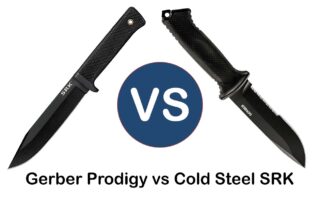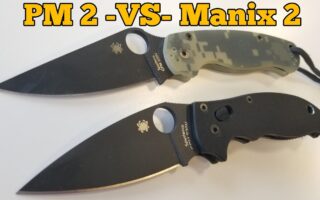Gerber Jukebox Knife Review
In case you haven’t heard of it: The battle between form and function continues. Sure, in a perfect world we’d have tools that would look fantastic and work well. The reality in the world of knives, however, is that most of us end up with ugly blades we love to hammer and lots of drawer queens we hesitate to use.
The Gerber Jukebox oddly fell in the middle of this continuum for me. Like most razor buyers, I initially saw its retro look and unique operation and couldn’t say no. However, after holding the piece in my hand, I ran into some clear drawbacks that kept me from absolutely falling in love with the design.
The irony of it all is that the fact that I didn’t like it at first made me tap and push a little harder than I normally would have. As a result, it’s one of the few knives I own that is both a beautiful showpiece and gets a frequent nod when there’s a job to be done.
General Dimensions and Blade Details
The Gerber Jukebox has a 2.75″ blade on a 3 7/8″ long handle. Much of the retro charm comes from a 7/8″ wide blade with a very steep drop between the spine and the tip. So much so that it looks more like a straight razor blade than a sheepsfoot. I find this blade shape suitable for most blue collar cutting tasks.
Compared to the usual suspects of the Spyderco PM2 and Ontario Rat II, the Jukebox is small but stubby. Closed, the knife is a hair under half an inch thick (not counting the clip) and sits about an inch and a quarter at its widest point. Overall, the knife is heavy without feeling bulky at 3.8 ounces on my digital scale.
Now the negative: the Gerber Jukebox uses 7Cr17MoV steel. This was new to me, and I had to do some googling: apparently it’s even cheaper than the standard Chinese 8Cr13MoV holder. Roughly equivalent to 440a, it should have slightly less edge retention than 8Cr, but be even easier to sharpen. Considering that almost all knives from a quality manufacturer today settle for 8Cr steel as the minimum grade, and given the $35-$40 price point of the Jukebox, this choice by Gerber seems odd.
What I can forgive less than the steel is the absolutely atrocious grinding of the mill, which was not only dull but completely asymmetrical. One side looked like a flat grind, the other like a hollow grind, and there was a noticeable difference in terms of where the grinds started from the back of the blade. At one time, I might have accepted this as what you’d expect from a “budget” knife, but the competition is tough these days. The sloppiness is even less excusable for a company trying to appeal to the enthusiast market segment.
You will notice that my knife does not have a perfectly straight edge and the tip is slightly rounded. This is my fault, not Gerber’s. To sharpen the knife, I used the WSKTS-W model from Work Sharp. Yes, the one that runs on electricity. I may have been a little too aggressive in my first use of the device, and went a little too heavy-handed with the coarse grit strip. Perhaps my lack of finesse was particularly unsuitable for the softer 7Cr steel. Live and learn. In my defense, it gave the Jukebox a razor sharp edge for the first time in its life, and as the kids say, you only live once.
Handle, Ergonomics, and Pocket Clip
The biggest highlight of the Gerber Jukebox is without a doubt the tortoiseshell finish of the acrylic handles. They are simply amazing and hopefully this will catch on. For many of us, one cool feature of a knife is reason enough to buy one for the collection, and this was the golden ticket that made the Jukebox land in my cart.
The ego is not bad when it comes to the Jukebox. It is very well rounded and contoured, so there are no hot spots. The stainless hardware is nicely polished, and the acrylic panels are well matched to the frame. The knife has a satisfying weight in the hand, and the handle is just the right size to allow a four-finger grip without feeling cumbersome.
One issue drove me crazy in a way that I’m glad wasn’t too significant. I realized that even though the Jukebox fits nicely in the hand, its symmetrical nature makes the knife difficult to orient when taken in the dark. Around 10pm I was setting up some boxes when I realized I had picked up the knife upside down. You’d think the flipper tab and pocket clip would serve as meaningful tactile clues as to which way the sharp end is pointing, but somehow I found a way to disorient the knife, so you’re on notice.
The Jukebox pocket clip is deep, pointing downwards. None of this should be a problem: the knife is easy to open and use with the left hand, and I don’t think this knife is designed for quick opening (more on that in the next section) or self-defence. However, it would not be inappropriate not to mention the reversal device. Some of the advantages of deep carry are somewhat negated by the half-inch metal protrusion. I wasn’t annoyed by the flipper, as some other online reviewers have mentioned, but it does make the knife a bit of an eyesore in the pocket.
Deployment and Lockup
I would upgrade my original assessment of Jukebox’s implementation from “clumsy” to a new verdict of “surprisingly satisfactory”.
First, you might look at the upward extension of the blade in the closed position and assume it’s a fidget-friendly front flipper. It’s not. The blade is under enough tension that you can’t easily flick it in deployment. Even if you try to build momentum with a flick of the wrist, the way you grip the blade means you’ll probably end up jamming your index finger between the handle and the extension before the line has a chance to engage.
If you are willing to accept the fact that your growth will not be immediate, you can have fun here. The Jukebox is actually quite easy to open with one hand. The thumb can roll the blade to a ninety-degree position, allowing the index finger to reach over the back of the tab and lock the blade in place. It may not be as quick as most EDC engagement methods, but after a bit of a learning curve, the process is very smooth. While the action is a little heavy for my taste, it is free of grain or any jams.
The locking is decent, but not excellent. My jukebox wobbles a bit when I apply a little force, but it doesn’t bother me. The liner is a little thin, but it consistently finds the center of the blade, even with light pressure. I wouldn’t insist on it, but it would be fine for light to moderate use.
Are Gerber Knives Still Good?
Yes, Gerber has been making quality knives for over 83 years. Their quality has changed slightly over time but overall their products have been consistently excellent. Gerber’s mission is to manufacture the highest quality knives in the world. They do this by utilizing the finest materials, workmanship and design.
Gerber Jukebox Review – Final Verdict
As you may have noticed, the steel of the blade, the design, and the ergonomics of the knife are features I like but don’t love. Given what Gerber is currently trying to do, the Fastball (and Gerber’s Custom Knife program) is more representative of the company’s potential and something that moves my personal needle a bit more than the Jukebox.
But allow me to compare it to baseball. If I look at my knives the way a manager looks at a pitcher, my Benchmade Bugout is one of my first “aces.” It gives me a lot of power, looks good doing it, and is a good choice for most situations. Conversely, something like the ESEE Junglas works as a “closer.” It’s not a common sight – on the contrary, it’s a special tool used when a particular problem needs to be solved decisively.
So, the Gerber Jukebox is the extra pitcher used in the middle of the game, when your team is in the lead. Sure, it is not as effective or efficient as another option, but often the work that needs to be done is not significantly affected by the limitations of this tool. You’ll also save the aces and closers unnecessary wear and tear by relying on this tool.
I mean, a pitcher of this type has a place in any bullpen, and a Gerber Jukebox fits in many a knife drawer. It’s not a perfect knife, but it’s an imaginative knife that you can definitely train with.
GERBER Jukebox EDC Pocket Knife
-
Blade(4)
-
Handle(3)
-
Quality(3.5)
-
Value(3.5)
Summary Review
With a nod to the past, the Jukebox Knife is a high-quality, full-tang folding knife that features a classic style with a modern twist. This knife is built around a titanium frame and a carbon fiber handle that’s made to be both lightweight and comfortable in your hands. The blade is made from 440 stainless steel and has a full edge profile.
The blade is extremely well balanced and the weight of the knife is distributed perfectly in your hand. If you want a knife that will feel comfortable and easy to use at all times, this is the knife for you.
A quick tip for the first time users: the blade lockup feature is really easy to use, but you can also use the thumbstud if you prefer. You won’t have any issues with it slipping out of your hand if you’re not used to it, so don’t worry.
This is the perfect knife for your everyday carry, camping, or fishing adventures. With its classic design and great blade, you’ll never go wrong with the Jukebox Knife.
Overall
3.5Pros
- Hand forged blade made by Stainless Steel
- Great finish and sharpness
- Great grip
- Great size
- Good steel
Cons
- Price tag is high

Hi, my name is Taras Kulakov and I’m a knife enthusiast. I have been collecting knives for over 30 years and I’ve owned literally thousands of different models over that time. My goal with this site is to share some of what I’ve learned about knives. You can find more info about Taras Kulakov here.

![The 10 Best American Made Bowie Knives of [year] 2 Best Bowie Knives Reviews](https://knivesngear.com/wp-content/uploads/2021/12/Best-Bowie-Knives-Reviews-and-Buying-Guide-320x200.jpg)
![5 Absolute Best Camping Knives For Campers [year] 3 Best Camping Knives](https://knivesngear.com/wp-content/uploads/2021/05/Best-Camping-Knives-320x200.jpg)


